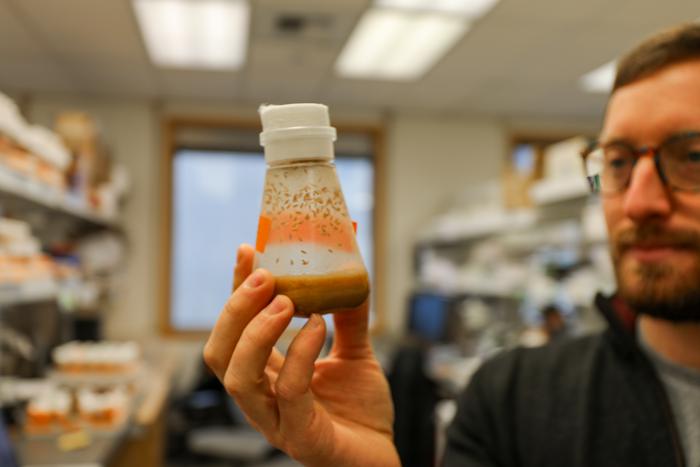Astrocytes, the star-shaped glial cells long overshadowed by neurons in neuroscience research, are emerging as dynamic and essential players in brain function. New research from Oregon Health & Science University (OHSU), published in Science, reveals that these abundant cells do far more than merely supporting neurons; they actively participate in modulating brain activity in real time. Utilizing the genetically tractable model of fruit flies, researchers have uncovered complex signaling mechanisms by which astrocytes respond selectively to neurotransmitters, opening new avenues for understanding cognition and neurological disorders.
Historically, astrocytes were considered passive caretakers of the brain’s primary signaling cells — neurons — providing metabolic support and clearing waste products to maintain neuronal health. However, accumulating evidence over the past decade has begun to challenge this narrative. The current study builds on groundbreaking findings from 2016 by the same research group demonstrating that astrocytes can themselves transmit signals, suggesting a deeper integration into neural circuits than previously recognized. This latest work goes further by elucidating the intracellular biochemical pathways that allow astrocytes to gate their responsiveness to various neurotransmitters including dopamine and glutamate, chemicals fundamental to neuronal communication.
The key to astrocytes’ nuanced control lies in G protein-coupled receptor (GPCR) signaling pathways present within each astrocyte. These receptors detect extracellular neurotransmitter signals and initiate intracellular cascades that regulate astrocyte activity. The OHSU team discovered that through modulating GPCR activity, astrocytes can be “turned on or off” in their ability to respond to the synaptic milieu. This selective gating mechanism enables an astrocyte to filter and prioritize inputs from the myriad synapses it surveils — a single astrocyte can contact over 100,000 synapses — thereby orchestrating neuronal ensembles dynamically based on immediate behavioral demands.
In vivo neural imaging of the fruit fly brain, combined with targeted genetic manipulation, revealed that disrupting this astrocytic gating results in significant behavioral impairments, underscoring the functional importance of these cells in cognitive processing. The researchers extended their findings to rodent models, confirming evolutionary conservation of this mechanism and hinting at its fundamental role across species. This cross-species consistency suggests that astrocytic modulation of neuronal activity is an ancient feature likely critical for survival, enabling animals to swiftly recalibrate brain states in response to environmental threats or opportunities.
Lead author Kevin Guttenplan, Ph.D., emphasizes the evolutionary advantage of such rapid brain-wide modulation: when a predator looms, the brain must instantaneously suppress distractions and concentrate neural resources on escape behaviors. Astrocytes, through their complex synaptic integrations and signaling plasticity, appear to act as crucial conductors, enabling this swift transition among neural network states. Such orchestrated activity goes beyond classical views of neural signaling limited to neuron-neuron interactions, highlighting a richer, multi-cellular conversation underlying cognition.
The implications of this research extend to understanding neuropsychiatric and neurodegenerative diseases. Malfunction or dysregulation of astrocytic GPCR signaling may contribute to the attentional deficits and mood disturbances commonly observed in conditions like Alzheimer’s and Parkinson’s diseases. While neurons have traditionally been the primary focus of drug discovery, astrocytes now emerge as promising therapeutic targets. Regulating astrocyte responsiveness could refine brain circuit function, ameliorate cognitive deficits, and offer innovative strategies to combat brain disorders.
From a mechanistic standpoint, the study delves into the sophisticated interplay between dopamine and glutamate neurotransmitter systems and astrocytic GPCRs. Dopamine modulates reward and attention pathways, while glutamate mediates excitatory signaling crucial for learning and memory. By toggling sensitivity to these neurotransmitters, astrocytes may modulate synaptic strength and plasticity dynamically, shaping behavioral outcomes. This fine-tuned gating challenges the simplistic binary of excitation and inhibition, painting a picture of a flexible, context-dependent neural environment.
Senior author Marc Freeman, Ph.D., director of the OHSU Vollum Institute, envisions this work pivoting neuroscience toward an integrated framework where astrocytes are recognized as both regulators and participants in neurophysiology and behavior. This paradigm shift encourages revisiting the underlying principles of brain network function and exploring astrocytes’ role in mental health regulation, including attention, anxiety, and mood disorders — areas currently underscored by enormous unmet medical needs.
The technical approach of the study relied on sophisticated imaging modalities to monitor calcium signals within astrocytes, a proxy for their activity, alongside optogenetic and pharmacogenetic tools to manipulate signaling pathways precisely. Such experimental rigor, coupled with the powerful genetic toolkit available in Drosophila, provided unprecedented resolution in dissecting astrocyte functions. Importantly, these insights were validated through rodent studies, further cementing their relevance to human brain physiology.
Despite this exciting progress, the researchers caution that astrocytes’ complexity presents formidable challenges. Each astrocyte integrates thousands of synaptic inputs, with their gating mechanisms modulated by a myriad of biochemical and electrical cues. Extrapolating from single-cell analyses to the coordinated operations of millions of astrocytes spanning distinct brain regions remains a daunting endeavor. Nonetheless, understanding these processes at cellular and systems levels could transform neuroscience and medicine.
As neuroscientific exploration advances, astrocytes have transitioned from the periphery to center stage. This study represents a leap forward in appreciating their active roles in cognitive functions. The findings not only enrich our basic understanding of brain architecture but also illuminate novel pathways to addressing cognitive impairments through astrocyte-targeted interventions. Future studies expanding on GPCR-regulated astrocyte responsiveness may ultimately unlock new therapeutic potentials for a variety of brain disorders.
In summary, astrocytes are not just passive support cells but dynamic, selective regulators of neuronal signaling networks. Their ability to gate neurotransmitter responsiveness via GPCR pathways confers on them the power to shape brain states contextually and rapidly. By embracing this intricate glial contribution, neuroscience stands on the cusp of a more holistic understanding of brain function and its disorders, promising to revolutionize approaches to mental health and neurodegeneration.
Subject of Research: People
Article Title: GPCR signaling gates astrocyte responsiveness to neurotransmitters and control of neuronal activity
News Publication Date: 15-May-2025
Web References: http://dx.doi.org/10.1126/science.adq5729
References: Research article published in Science, DOI 10.1126/science.adq5729
Image Credits: OHSU/Christine Torres Hicks
Keywords: Behavioral neuroscience, Cognition, Emotions, Glia, Neurotransmission, Dopamine, Glutamates, Neurodegenerative diseases




